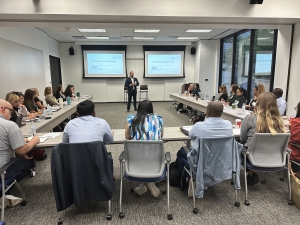Jim Wicklund, Managing Director of Credit Suisse, presented an economic outlook on industry trends at the PESA 2015 Membership Meeting on November 10 in Houston. PESA Chairman Gary Halverson, Sr. Vice President & President – Drilling & Production Systems of Cameron International opened the meeting and greeted current and prospective PESA members. Mike Kowalski, Jr., Advisory Board Member and Vice President & Chief Operating Officer of Sunbelt Steel shared how his company has benefitted from PESA membership and encouraged individuals to get involved. He discussed the networking, training and leadership development opportunities within PESA before introducing Wicklund.
Wicklund spent 15 years in the oil and gas industry in geophysics and engineering before joining the financial services industry as a research analyst covering the Oilfield Services sector. He has received various awards and recognition including #1 rankings in Institutional Investor and the Wall Street Journal’s “Best on the Street” and was a frequent contributor to CNBC, CNN and other media outlets.
Wicklund shared his perspective on the state of the industry as well as a forecast for the coming years. According to Wicklund, recently there has been an unprecedented rise in production but not in sales. The U.S. has an exceptionally strong surplus production environment but not a strong demand environment.
- In 2014 U.S. oil production grew by 1.3 million barrels per day, which is more than any country in the history of the industry.
- The success of shale almost doubled U.S. oil production in less than five years and is affecting U.S. foreign policy as well as its strategic position in energy.
- For the first time, the U.S. is producing enough oil to impact the world market which has led to an imbalance of supply and demand.
The Gulf Cooperation Council recently acknowledged that the U.S. is now the swing producer. “When the world is short on oil, they look to us,” stated Wicklund. “However, when we have a surplus, it is the swing producers’ responsibility to balance the global supply and demand.” Oil prices govern production levels and keep them from skyrocketing when the demand is low. In 2014, this caused Exxon, Chevron, BP, Shell and other producers to change their strategic objectives from a focus on production growth to return growth which resulted in a restructuring of the service and supply sector. As capital expenditures are expected to decrease by 25% this year, the rig count will also continue to drop.
- The U.S. rig count is down almost 50% but as soon as oil prices increase in a meaningful way, so will the rig count.
- The rig count should rise to 700 by the fourth quarter of 2016.
- Over the past two years, feet drilled in the U.S. has dropped by 3.2 million.
Wicklund states exploration and production companies tend to think if production does not increase they will go out of business. However, the shale revolution is changing the industry and switching the focus from deepwater to onshore production. Deepwater presents more challenges, while a faster cash return cycle and more diverse activity base will allow onshore to recover more quickly from the downturn.
- Deepwater oil production growth has been zero for the past three and a half years.
- Onshore increased production by 5 million barrels a day in five years.
- 75% of major IOC deepwater projects were un-economic at $100 oil.
- Day rates for offshore drillers decreased by 50% in 2015.
- Deepwater has a seven year cash return cycle and onshore has a three year cash return cycle.
According to Wicklund, although this is the worst downturn in three decades, the balance of the global crude oil market will be closer to normal in 2016. He predicts that although businesses will recover, the way they operate will change. With more oil deposits identified, less economic risk in exploration remains. Additionally, because 35% of the industry has already been laid off, there is no longer any excess, driving efficiencies in the future.
“You’re coming up with more efficient ways to do things by developing technologies that are revolutionizing the business,” said Wicklund. With more than 400 offshore discoveries waiting to be developed and access to unconventional plays, he anticipates a quicker recovery than in the 1980s.
“The oil and gas industry is an incredibly resilient business. The optionality of good times can’t be beat and we are truly a hyper cyclical market,” stated Wicklund. “We always recover, we always return and we are always stronger for it. We will this time as well.”
Download the presentation.
View the photo album on Facebook




